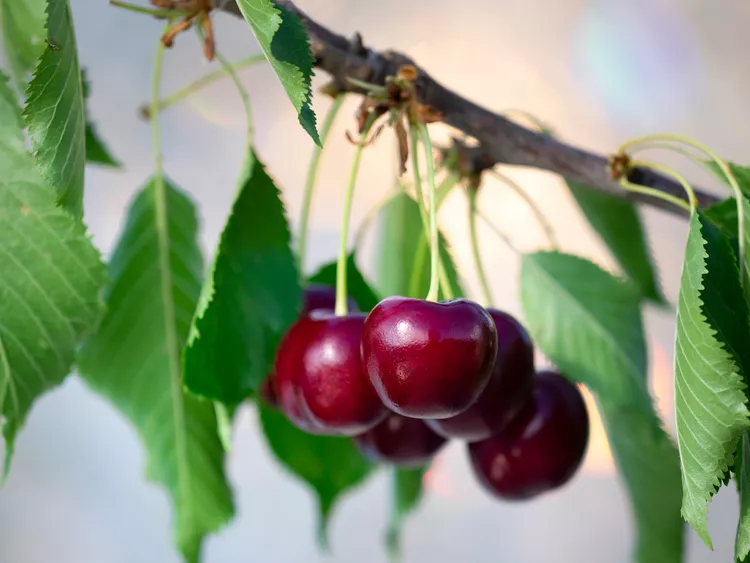How to Plant Cherry Seeds and Nurture Seedlings into Trees

If you've snacked on plump and juicy cherries, you know a pit (a seed) lies at the center of the fruit. Although purchasing and planting grafted seedlings is a more common growing method, you can produce cherry trees by planting these seeds, too.
Referred to as "stone fruits" like their cousins plums, peaches, and apricots, cherries are relatively easy to grow in a home garden. Once the fruit-bearing tree reaches maturity, it can yield buckets of flavorful cherries. To fill your own buckets, learn how to plant cherry seeds indoors and outdoors, nurturing seedlings into lush trees laden with fruit.
Types of Cherry Trees
Favored for their sweet, tart, and tangy flavors, cherries are scrumptious in baked goods or eaten fresh. Two distinct types of edible cherry trees—sweet cherries and sour cherries—produce fruit with very different flavor profiles.
Sweet Cherries
Sweet cherries (Prunus avium), also known as wild cherries, are native to Europe, North Africa, and Western Asia. They also grow across much of North America and parts of Australia. Sweet cherries are hardy in USDA Zones 5-7 and grow to about 40 feet tall at maturity. They are usually grown for eating fresh, with 'Bing' being one of the most popular varieties.
Aside from the common rootstock cultivar, 'Mazzard', most sweet cherries require a second, compatible cultivar to pollinate. This also means that most sweet cherry seeds will not breed true to type (i.e. the resulting tree won't be a copy of the parents). However, unlike many other types of fruit that require cross-pollination, offspring from such crosses tend to be just as tasty as the parent plants, albeit the resulting trees will likely have a different habit, form, and flavor profile.
Sour Cherries
Sour cherries (Prunus cerasus), also known as dwarf cherries or tart cherries, are a hybrid of the sweet cherry and European dwarf cherry (Prunus fruticosa) that has become a species in its own right. They're hardy in Zones 4-6, making sour cherries slightly hardier than sweet cherries.
Due to their European dwarf cherry parentage, sour cherries are generally smaller than sweet cherries when planted on their own rootstocks. You can expect them to reach about 20 feet tall. Sour cherries are self-pollinating and generally breed true from seed. These cherries are mostly used for cooking and baking.
Can Cherries Be Grown from Seeds?
Cherries grow from seed relatively easily, especially in colder regions of the United States. By following these steps outlining how to plant cherry seeds, you can harvest your own fruit within about 10 years. Just remember that not all cherries will come true from seed. In other words, the cherry seed you plant might not bear fruit that tastes the same as the fruit from which it came.
If you want to grow cherries from seed, use sour cherry seeds for best results.
How to Plant Cherry Seeds Indoors
- Starting with fresh cherries, remove the pits and clean off as much of the fruit as possible.
- Once clean, allow seeds to dry in a warm, dry place out of direct sunlight for a few days.
- Wrap dried seeds in a slightly damp paper towel or sphagnum moss, then place in a plastic bag or glass jar.
- Place prepared seeds in a refrigerator or cold cellar for approximately three months. Check the seeds periodically for new growth and remove any that have begun to grow.
- After three months, plant the pits in a seed tray or seed-starting pot filled with moist, sand-based potting mix. Give each seed a few inches of space to avoid overcrowding.
- Place planted seeds in a south-facing window or greenhouse. Keep them warm and do not allow the soil to dry out.
- Seedlings should begin to emerge from the soil surface within about two weeks. After seedlings have grown their second set of leaves, they can be planted in individual pots.
- Harden off seedlings in spring by taking them outside and placing them in a location that receives morning sun or dappled shade for about a week. After they have adjusted to being outdoors, seedlings should be placed in full sun.
How to Plant Cherry Seeds Outdoors
An alternative to starting seeds indoors is to sow cherry seeds outdoors in the fall in areas where they are hardy. Place cleaned and dried seeds in a sand-based mix. Leave planted seeds outdoors in a full sun location, fully exposed to the elements as they would be in nature. Fallen leaves and snow cover will help keep the seeds moist during drier periods. In spring as temperatures warm up, seedlings will begin to sprout. They can be transplanted after a second set of leaves has emerged.
How to Care for a Cherry Tree
Cherry trees are relatively fast-growing and require little care compared to other fruit trees, but these tips will help your cherry thrive.
- Plant your cherry seeds or seedlings where they can grow in full sun.
- Protect seedlings and immature trees from wildlife by wrapping the trunk and lower branches in burlap or tree wrap in the winter.
- Avoid pruning cherry trees during winter dormancy. Instead, wait until early spring just before new buds begin to open.